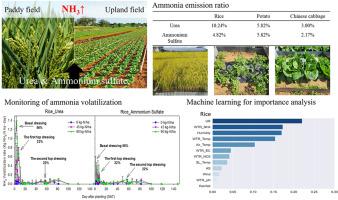当前位置:
X-MOL 学术
›
Atmos. Pollut. Res.
›
论文详情
Our official English website, www.x-mol.net, welcomes your feedback! (Note: you will need to create a separate account there.)
Comparison of ammonia volatilization in paddy and field soils fertilized with urea and ammonium sulfate during rice, potato, and Chinese cabbage cultivation
Atmospheric Pollution Research ( IF 4.5 ) Pub Date : 2024-01-13 , DOI: 10.1016/j.apr.2024.102049 Yeon-Jin Lee , Eun-Chae Im , Gyesik Lee , Seong-Chang Hong , Chang-Gu Lee , Seong-Jik Park
Atmospheric Pollution Research ( IF 4.5 ) Pub Date : 2024-01-13 , DOI: 10.1016/j.apr.2024.102049 Yeon-Jin Lee , Eun-Chae Im , Gyesik Lee , Seong-Chang Hong , Chang-Gu Lee , Seong-Jik Park

|
Ammonia in fertilizers used in agriculture is emitted into the atmosphere, which can be a precursor to the formation of fine dust that deteriorates air quality. This study investigated ammonia emissions from paddy and upland fields when urea (UR) and ammonium sulfate (AS) were used to grow rice, potato, and Chinese cabbage. Ammonia emissions from agricultural fields, water/soil properties, and meteorological data were monitored. In the paddy fields, the highest level of ammonia emissions was observed immediately after basal fertilization. However, this trend was not observed in the upland fields, where the application of a top dressing to moist soil led to an increase in ammonia emissions. In rice paddy fields and Chinese cabbage upland fields, higher ammonia emissions were observed under UR fertilization than under AS fertilization; whereas, no discrepancy was observed in the potato upland fields. A random forest model was used to determine the importance of environmental variables in ammonia emissions. The results indicated that UR application was the most significant factor affecting ammonia emissions, followed by the NH concentration in ponding water in paddy fields. In upland fields, the soil water content was an important factor, and the temperature of ponding water influenced ammonia emissions. Most of the agronomic traits of rice and Chinese cabbage improved with increased amounts of fertilizer, whereas such a trend was not observed for potato. This study provides new insight into the environmental factors influencing ammonia emissions in agricultural settings. These findings serve as a foundation for the development of strategies and practices aimed at mitigating future ammonia emissions.
中文翻译:

水稻、马铃薯、大白菜种植期间施用尿素和硫酸铵的稻田和大田土壤氨挥发比较
农业肥料中的氨被排放到大气中,这可能是细粉尘形成的前兆,从而恶化空气质量。本研究调查了使用尿素 (UR) 和硫酸铵 (AS) 种植水稻、马铃薯和大白菜时稻田和旱地的氨排放。监测了农田的氨排放、水/土壤特性和气象数据。在稻田中,施基肥后立即观察到氨排放量最高。然而,在高地田地中并未观察到这种趋势,在高地田地中,对潮湿土壤施追肥导致氨排放量增加。稻田和大白菜旱地,UR施肥氨氮排放量高于AS施肥;然而,在马铃薯旱田中没有观察到差异。使用随机森林模型来确定环境变量在氨排放中的重要性。结果表明,施用UR是影响稻田氨氮排放的最显着因素,其次是稻田积水中NH浓度。在旱地,土壤含水量是一个重要因素,积水温度影响氨氮排放。水稻和大白菜的大部分农艺性状随着施肥量的增加而改善,而马铃薯则没有观察到这种趋势。这项研究为影响农业环境中氨排放的环境因素提供了新的见解。这些发现为制定旨在减少未来氨排放的战略和实践奠定了基础。
更新日期:2024-01-13
中文翻译:

水稻、马铃薯、大白菜种植期间施用尿素和硫酸铵的稻田和大田土壤氨挥发比较
农业肥料中的氨被排放到大气中,这可能是细粉尘形成的前兆,从而恶化空气质量。本研究调查了使用尿素 (UR) 和硫酸铵 (AS) 种植水稻、马铃薯和大白菜时稻田和旱地的氨排放。监测了农田的氨排放、水/土壤特性和气象数据。在稻田中,施基肥后立即观察到氨排放量最高。然而,在高地田地中并未观察到这种趋势,在高地田地中,对潮湿土壤施追肥导致氨排放量增加。稻田和大白菜旱地,UR施肥氨氮排放量高于AS施肥;然而,在马铃薯旱田中没有观察到差异。使用随机森林模型来确定环境变量在氨排放中的重要性。结果表明,施用UR是影响稻田氨氮排放的最显着因素,其次是稻田积水中NH浓度。在旱地,土壤含水量是一个重要因素,积水温度影响氨氮排放。水稻和大白菜的大部分农艺性状随着施肥量的增加而改善,而马铃薯则没有观察到这种趋势。这项研究为影响农业环境中氨排放的环境因素提供了新的见解。这些发现为制定旨在减少未来氨排放的战略和实践奠定了基础。



























 京公网安备 11010802027423号
京公网安备 11010802027423号